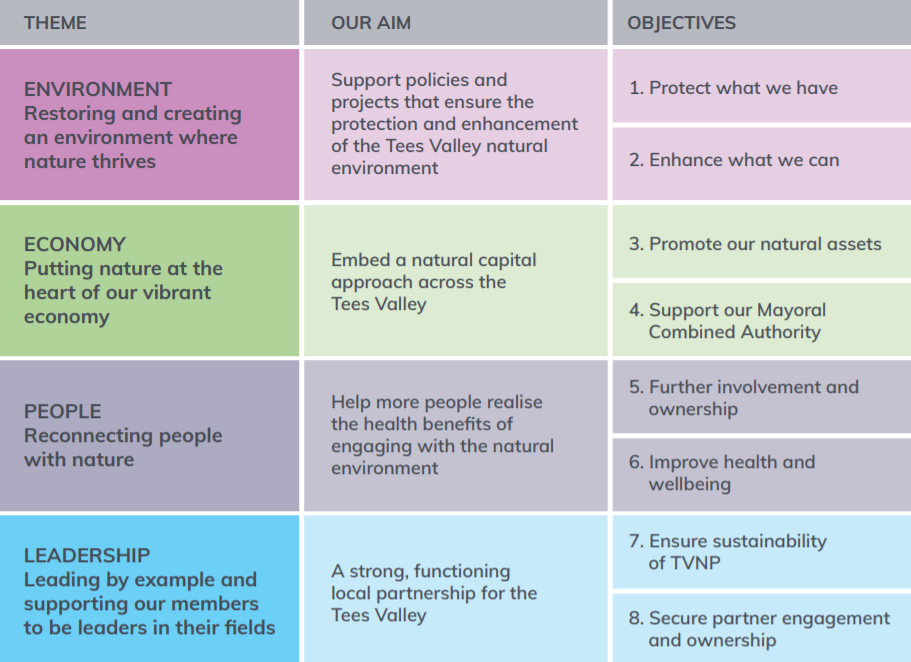About this assessment
This is an assessment tool to ensure that nature and biodiversity considerations are included in the Local Plans at any stage of the policy planning or review. A series of principles to evaluate this have been developed using the NPPF and NPPG that support the priorities and outcomes devised by The TVNP.

Figure 1: 2019 -2022 TVNP summary of 3 themes and aims with 8 objectives to achieve the vision
Guiding principles:
- Protect, enhance and expand the ecological network* in the Tees Valley (natural connectivity).
- Take a landscape-scale approach to the natural environment ensuring decisions are across borough boundaries.
- Protect and enhance existing natural assets and green infrastructure.
- Ensure decisions make use of the most up to date and accurate ecological data. Is there additional data that could be used?
- Incorporate/take into account mitigation and adaptation to climate change.
- Ensure the improvement in the quality and accessibility of public open space through adequate long term management.
- Promote/provide opportunities for people to explore the natural environment through rights of way and cycle networks.
- Promote the transition to a low carbon economy and diversify the local economy.
- Support sustainable ecosystem services i.e.the benefits people get from nature.
* Ecological networks are intended to help conserve biodiversity where patches of semi-natural habitat have become isolated within intensively used landscapes.
Why the need for a Tees Valley wide local plan assessment?
- Duty to cooperate under the Town and Country Planning Regulations Local planning authorities must cooperate with Local Nature Partnerships (LNP’s) [1] and have regard to their activities when they are preparing their Local Plans, so long as those activities are relevant to local plan making.
- The NPPF – National Planning Policy Framework along with its planning practice guidance (NPPG) sets out the Government’s planning policies for England and how these are expected to be applied. First published in 2012 and update 24th July 2018. The most recent revision made it clear that ‘The purpose of the planning system is to contribute to the achievement of sustainable development. At a very high level, the objective of sustainable development can be summarised as meeting the needs of the present without compromising the ability of future generations to meet their own needs’. A number of paragraphs in the framework specifically relate to LNP’s:
- NPPF 11 Plans and decisions should apply a presumption in favour of sustainable development.
- NPPF 25 Strategic policy-making authorities…should also engage with their local communities and relevant bodies including Local Enterprise Partnerships, Local Nature Partnerships, the Marine Management Organisation…elected Mayors and combined authorities
(in cases where Mayors or combined authorities do not have plan-making powers (editors note: e.g Tees Valley))
- Section 40 of the Natural Environment and Rural Communities Act 2006 places a duty on every public authority to conserve biodiversity.
- To ensure consistency across the five Tees Valley local authorities. In addition, in the duty to cooperate there is a requirement that local planning authorities work with local planning authorities and bodies outside their area.
- To enable joint research and evidence gathering to define the scope of the local plan, assess policy impacts and assemble the necessary material to support policy choices. This could include the production of a more detailed Tees Valley wide opportunities map.
[1] “local nature partnership” means a body, designated by the Secretary of State, which is established for the purpose of protecting and improving the natural environment in an area and the benefits derived from it.
There were https://aircargoupdate.com/news-musculoskeletal-pain-pills-online-reliable-worldwide-delivery/ severe pains. I bought Soma and took course. After making sure that the pain was gone, stopped using and started physical activity and other moving activities, and the pain began to appear again. After repeated use, I realized that it anesthetized well, but did not completely cure the disease.
Completing the assessment:
tvnp-local-plan-assessment-v2 for an editable copy please email: [email protected];
The Local Plan can be scored against each TVNP desired outcome, brief evidence must be shown for what choice is made. At the end a score is generated and assessment made of what action, if any is needed. This is then submitted to TVNP Planning and Nature Working Group who will review, comment and ultimately ‘sign off’ the final assessments.
For advice on completing this assessment please contact the TVNP Manager Rachel Murtagh: [email protected]; 01287 636382
Additional resources:
- CIEEM: Biodiversity Net Gain. Good practice principles for development. A practical guide.
- May 2019: Natural Capital Committee advice to government on net environmental gain
POST ASSESSMENT ‘Duty to Co-operate’ letters to planning authorities:
Darlington Borough Council (to follow)
Hartlepool Borough Council TVNP H’pool Duty to coop letter
Middlesbrough Borough Council (to follow)
Redcar & Cleveland – TVNP R&C Duty to coop letter
(response) RCBC DtC letter TVNP
Stockton-on-Tees Borough Council – TVNP S’ton Duty to coop letter 1
TVNP S’ton Duty to coop letter 2
Local strategies related to this guidance:
Tees Valley:
Tees Valley Natural Networks & Opportunity Maps
Tees Valley Green Infrastructure Strategy
Tees Valley Local Standards for Sustainable Drainage
Tees Valley Climate Change Strategy
Tees Valley Joint Minerals and Waste Development Plan Documents (DPD) – link to further documents
Darlington:
Darlington’s Green Infrastructure Strategy 2013 – 2026
Darlington Open Space Strategy 2007 – 2017 with 2010 OSS update report
Hartlepool:
Green Infrastructure Supplementary Planning Document (SPD) and Action Plan
Middlesbrough:
Middlesbrough Green Spaces Strategy
Middlesbrough One Planet Living
Redcar & Cleveland:
Redcar & Cleveland’ s Sustainable Environment Strategy 2011 – 2016
Redcar & Cleveland Climate Change Plans
Redcar & Cleveland Carbon reduction plans and strategies
Stockton:
Stockton Green Infrastructure Strategy 2011
Climate Change; Strategy for Stockton 2016 – 2021
Further useful links:
Tees Valley:
Environmental Information Records Centre – North East
National:
UK Government 25 Year Environment Plan published 2018
2017 UK White Paper on housing market
The Conservation of Habitats and Species Regulations 2010
Biodiversity 2020: A strategy for England’s wildlife and ecosystem services
Biodiversity and geological conservation: circular 06/2005 – guidance on the application of the law relating to planning and nature conservation as it applies in England
Biodiversity Offsetting Guide – The Environment Bank Ltd
Criteria to apply when identifying Nature Improvement Areas
Flood risk assessment: local planning authorities
Health and Wellbeing – the role in planning
National pollinator strategy: for bees and other pollinators in England
Natural Environment White Paper section 2.12 explains the components of an ecological network
Nature Nearby – Accessible Natural Greenspace Guidance (NE265)
Planning Practice Guidance – Climate Change
Planning Practice Guidance – Natural Environment
Shoreline management plans (SMPs)
Sustainable Drainage Systems – House of Commons written statement
The Water Environment (Water Framework Directive) (England and Wales) Regulations 2003
